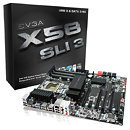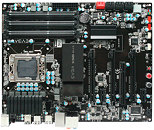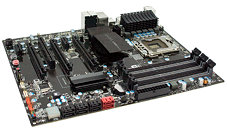Tuesday, August 31st 2010

EVGA Intros Affordable X58 SLI3 Motherboard
EVGA released its newest socket LGA1366 motherboard, the EVGA X58 SLI3 (model: 131-GT-E767-TR). This model completes EVGA's lineup of new LGA1366 motherboards that pack USB 3.0 and SATA 6 Gb/s support, other models include the EVGA X58 FTW3 and EVGA X58 Classified3. Among the three, the X58 SLI3 is the most affordable, and targets a sub-$200 price point. The model and its overall design are derived from the X58 SLI, but with 2-port USB 3.0 and SATA 6 Gb/s controllers.
The LGA1366 socket is powered by a 6-phase VRM, it's wired to six DDR3 DIMM slots for triple-channel memory support. The motherboard supports all released Intel Core i7 LGA1366 processors, including the six-core models, out of the box. Expansion slots include one PCI-Express 2.0 x16, two PCI-Express 2.0 x16 (electrical x8), two PCI-E x1, and one PCI. 2-way and 3-way SLI are supported. Apart from the six SATA 3 Gb/s ports from the ICH10R southbridge, there are two SATA 6 Gb/s ports (color coded red). Connectivity includes 8-channel HD audio, gigabit Ethernet, two USB 3.0 and a number of USB 2.0 ports. The EVGA X58 SLI3 is listed on the company's store, at US $199.99.
The LGA1366 socket is powered by a 6-phase VRM, it's wired to six DDR3 DIMM slots for triple-channel memory support. The motherboard supports all released Intel Core i7 LGA1366 processors, including the six-core models, out of the box. Expansion slots include one PCI-Express 2.0 x16, two PCI-Express 2.0 x16 (electrical x8), two PCI-E x1, and one PCI. 2-way and 3-way SLI are supported. Apart from the six SATA 3 Gb/s ports from the ICH10R southbridge, there are two SATA 6 Gb/s ports (color coded red). Connectivity includes 8-channel HD audio, gigabit Ethernet, two USB 3.0 and a number of USB 2.0 ports. The EVGA X58 SLI3 is listed on the company's store, at US $199.99.



15 Comments on EVGA Intros Affordable X58 SLI3 Motherboard
facepalm
But be glad they didn't classify it as "budget", that would make the 24-pin move to the left side of the board, right to where the 8-pin is now. And probably the USB and audio headers scattered on the board, instead of neatly placed on the bottom.
Although i admit other than that it looks like a pretty nice "affordable" board.
Well, I guess I can answer my own question, because it'd be a mess to do the traces that way and it would increase the complexity and cost of the board.
Once again, thanks to the ATX standard which is way outdated we're stuck with boards that has less than an ideal layout for the demands of a modern computer.
A bigger problem with this board imho is that both of the lower two x16 slots are only x8, so this board is not exactly ideal to use with two cards as EVGA didn't implement switching. I guess that's one way to cut cost...
I admit though i dislike it even being in the top left corner of the board as i would love it to be over by the 24 pin connector.